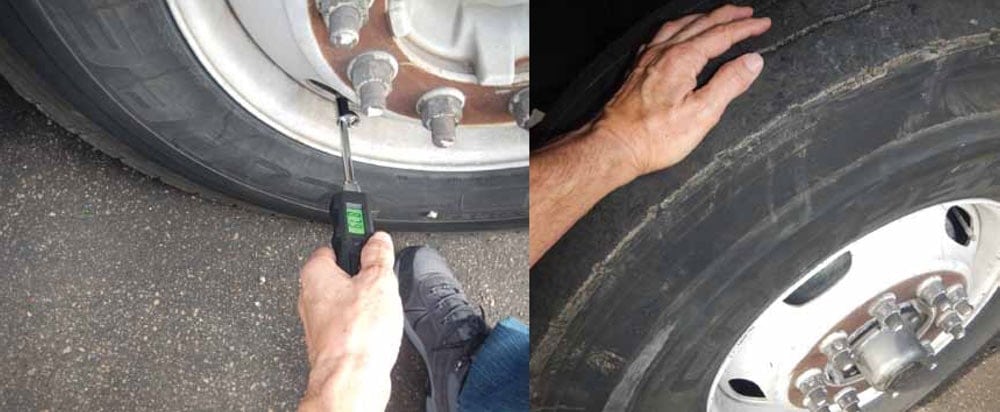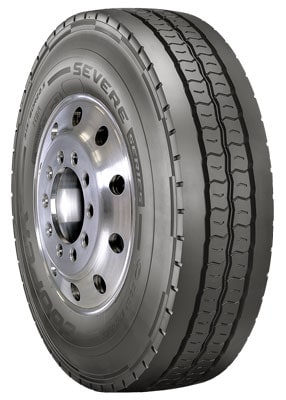Tire engineers design wear-resistant sidewalls and tread using advanced rubber compounds for optimal performance in waste haul applications.
By Phil Mosier
At the end of the day, all tires seem the same—they are round and black. It might seem that way to most people, but in the eyes of a tire engineer, one of the many differences is where the rubber meets the road. As you are surely aware, there are two types of waste haul operations—one is transfer trucks that take the refuse from point A to point B; the second is what people think of as garbage trucks that go from location to location picking up trash. Making a trip to the refuse plant or landfill can be an adventure to say the least, as once the truck leaves the pavement it may have to navigate a minefield of sharp gravel, metal scraps and other obstacles that can puncture tires and cause chunking. Trucks with regular routes in city neighborhoods, that are constantly stopping and starting—making sharp turns and working close to curbs—even if they are not logging long distances, have a tendency to eat tires too.
Scrubbing is one of the meanest enemies of waste haul tires primarily due to the high torque from both the engine and the brakes. To fight scrubbing, waste haul tires are designed with thicker sidewalls, as well as tread compounds that are more resistant to wear caused by maneuvering in tight locations with high axle loads.
In the Mix
The most important step in tire design is listening to customer feedback. For good reason, fleets managers are most concerned with the durability of the tire and its ability to be recapped to extend usability—these criteria also contribute to fleet management’s ‘oh so important’ bottom line.
The tread life of a waste haul tire can be much lower than a line haul tractor. Steer tires on a waste hauler can last anywhere from one to three months, whereas tires on a line haul tractor can last one to two years. Because of the shorter distances traveled, waste haul tires can be retreaded three-plus times if well maintained.
TIP: A typical highway tire can wait until the tread is 2/32-inch deep in the drive and trailer positions, and 4/32-inch for steer tires and still be legal. However, running a tire this thin in severe service applications is asking for trouble—pulling at 8/32-inch will lessen the likelihood of casing damage from penetrations.

Photo courtesy of Cooper Tire & Rubber Co.
The correct compound formula can add months of life to a waste haul tire, as can tread design. It is a mix of mostly natural rubber and/or some synthetic rubber, filler materials (typically carbon black and silica), waxes and oils as well as various chemical additives that promote elasticity, eco-friendliness and durability. One of the main ingredients is carbon black, a by-product of the burning of oil that gives tires their blackness. If rubber were not mixed with an additive like carbon black, a tire’s tread would be too soft and have no resistance to abrasion.
Silica, a basic component of ordinary beach sand, is traditionally used to enhance cut/chip/chunk resistance. Tire engineers discovered in the 1970s that rolling resistance could be reduced, and durability increased, by replacing some of the carbon black with reacted silica, but there was a trade-off. When combined with natural rubber tread compounds in commercial tires, the lower rolling resistance could potentially affect abrasion and wear resistance. Tests are made to examine factors such as tensile strength to ensure that compounds perform as expected and meet or exceed industry safety standards.

Test Tracking
Manufacturers are always working on ways to optimize tire performance. Before a new tire hits the market, it needs to be tested. Mounting the tire, and putting it on a wheel simulator, is one way to test it under “real world” speeds and conditions. From there, field engineers work directly with customers to study how well the tires respond to day-to-day work environments. Return analysis and feedback is gathered from multiple customers, and from that, continuous improvement is implemented on the tire design and construction.
TIP: It is well worth the few minutes it takes to carefully inspect tires and remove any debris or report it to the tire shop. Punctures penetrating through the belts should be sent in for proper repair to preserve the casing life. Not only can an undetected hazard cause a puncture or leak, but it can also damage the casing so much it cannot be retreaded.
Metropolitan areas with hot, dry climates, such as those in Southern California, are perfect testing grounds. The sunny weather might be great for vacationers, but when the heat index skyrockets, it puts added stress on tires. Combined with tight turns and constant starts and stops—all part of the job for waste haulers—friction turns to more heat. Bead area rubber is one aspect of tire construction in particular that needs to be able to withstand high temperatures from potential brake heat so the right blend of materials must be used to keep the rubber from breaking down.
Cold climates can have just the opposite effect. Where snow and ice are the norm, drive tires need to have superior traction. Tread compounds, therefore, need to provide traction plus low rolling resistance even when the rubber is cold. Mixed-use tires work extremely well in these conditions.
TIP: Maintaining proper tire inflation levels is one of the most important things you can do to preserve the durability of your tires. Under-inflation not only can lead to faster wear and loss of traction in turns, but it also causes increased flexing and subsequently increased heat buildup, causing damage to the casing structure.
The Big Picture
The impact that commercial tires have on the environment, and whether their new tires meet the Environmental Protection Agency’s (EPA) greenhouse gas (GHG) emissions requirements set for 2021, is something tire engineers take into great consideration. As manufacturers develop all commercial truck tires, one of the performance attributes taken into account is the tire’s rolling resistance, which plays a large role in fuel economy. Phase 1 sets the rolling resistance target at 7.7 for all vocational vehicles. When Phase 2 kicks in after 2021, each vehicle classification will have its own rolling resistance target. Tires designed for steer position in heavy-duty waste haul are 6.4, for example, while their drive tire counterparts are 7.8.
So, are all truck tires the same? Obviously not. Not only are there different tires for different applications, there are different sets of tires within the setup of the truck and trailer, and each of these will have different compounds. There is no universal tire or compound formula—not only would such a tire have a very limited application and customer appeal, but tire engineers would also be out of a job. The goal is to design tires with optimal performance, environmental advantages and safety benefits for today’s fleet and drivers. | WA
Phil Mosier is the Manager of Commercial Tire Development at Cooper Tire & Rubber Company (Findlay, OH). A 20-year tire professional, he is responsible for the design and development of commercial truck and bus tires for the North and South America regions. Phil and his team have brought to market many successful commercial truck tires in the Cooper Commercial Series and Roadmaster brand tire lines. The Cooper Severe Series lineup incorporates special cut, chip and chunk resistant compounds, plus Cooper’s Scrub Guard technology to help the tire withstand scrubbing, curbs and other obstacles typically encountered during operations, leading to longer tire life while maintaining casing integrity. The Cooper Severe Series WBA is designed to provide exceptional traction and cornering in slippery construction site conditions. The innovation is a five-rib design with 23/32nds of tread and a unique zigzag rib in the center.
For more information, e-mail [email protected].
You may also like:
Tires Made for Waste Haul Operations Manage Severe Operating Conditions
